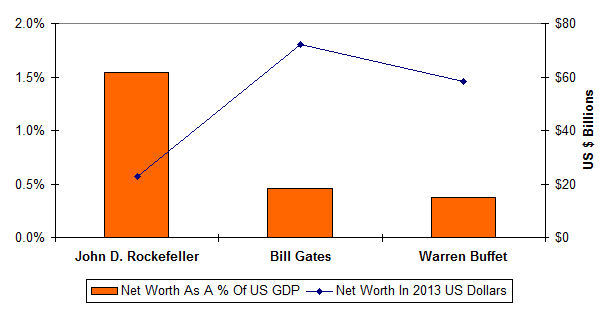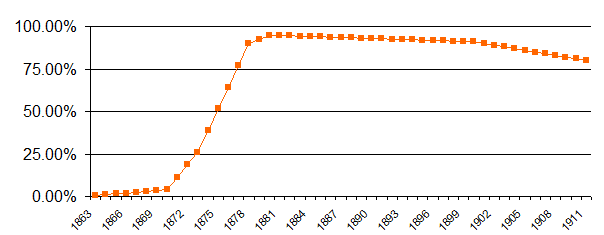John D Rockefeller's Business Strategy, Net Worth Analysis and His Secret To Success
In this blog article I have decided to take a look at one of the most successful american business man of all time....John D. Rockefeller. I take a look at his business strategy, what he did right, what he did wrong, his personal background, the timeline of his career/entrepreneurial endeavors and a analysis trying to understand exactly how wealthy he was and what his secret to financial success was.
Executive Summary
- John D Rockefeller amassed the largest empire of wealth known to man during the modern era
- John D Rockefeller built his empire through partnerships and acquisitions
- his main business strategies were reinvesting to speed growth, leveraging large scale buying power to reduce transportation costs, a focus on improving efficiency through economies of scale, vertical integration and buying out his competition
- his main marketing strategy was differential pricing
- his secret to making money was to give it away, in 1924 John D. Rockefeller wrote to his son and explained his practice of giving away money. He wrote, "...in the beginning of getting money, away back in my childhood, I began giving it away, and continued increasing the gifts as the income increased..." This is very similar to the advice found in Proverbs 11:24
What He Did Wrong
From any source you look at there is discrepancy about how John D Rockefeller conducted his businesses but there is a clear theme that in some instances he might have been accused of being ruthless with his competitors and suppliers. It sounds like he did not treat his competitors and suppliers always as he would have like to have been treated. It sounds like this changed over time but that there were some times where he. I can not know for sure since I was not there, but based on what I have read it appears that might have been the one main error of Rockefeller, which lead to his vast number of enemies and dislike by many, and the reason they pushed and won to have his company broken up. It appear that if he would have followed the golden rule (Matthew 7:12), he might have been able to avoid having to have his company split up.
What He Did Right
It is clear from all sources on his life that he tried to live a life of faith and God worked in him over time change his attitude and the way he conducted business to the point where he was changed to the point where he gave back a great portion of his fortune in the means of tithes and philanthropist. Over the course of his lifetime he gave away over $550 million dollars. "I would never have been able to tithe my first million dollars if I would not have tithed my first salary which was $1.50 a week". - John D. Rockefeller
Business Strategy - if you need a business strategy This email address is being protected from spambots. You need JavaScript enabled to view it.
Investing In The Business To Speed Growth via Borrowing and Profits
Early on Rockefeller used partnerships to add additional skills and resources to his ventures. In addition to this strategy he also exercised borrowing and reinvesting profits to compound the speed at which his enterprise was growing.
Reducing Key Costs By Amalgamating Purchases To Have More Bargaining Power
John also tried to control shipping costs by creating a cartel or the largest oil producers in partnership with the railroad companies allowing them to receive 50% reductions in freight costs.
In 1877 John started to expand into pipelines which his main delivery supplier, Pennsylvania Railroad, did not like too much. As a result Pennsylvania Railroad started buying and building refineries. As a result John held back using them for any of their shipments and partnered with other railroads to start a price war to reduce freight costs. Eventually John won and Pennsylvania Railroad sold all of its oil assets to Standard Oil.
Buying Out The Competition - Creating A Monopoly
In general John's strategy included buying out competition to give him a larger market share and more control, improving the efficiency of the operations, pressing for discounts on shipping costs to reduce his costs and undercutting his competitions pricing.
I order to get his competitors to agree to buying him out he simply would show them is books, highlighting how low of a cost he could compete. He would then outline how they could either compete with him in a price war forcing them to go bankrupt or they could agree to a purchase offer from him and salvage their something for their assets. He would explain how if they did not agree to his purchase offer that he would run them into -bankruptcy and then purchase up their assets from auction.
John also kept his competition to a minimum by keeping his prices low and even selling at cost or below cost to keep his competition out. He would undersell his competition and use differential pricing to maximize profits in areas where there was no competition, funding his ability to lower prices where there was competition. This approach worked and by 1878 Standard Oil was refining 90% of the oil in the US. This later caused problems as court proceedings followed shortly after in 1879 for its monopolizing the oil trade.
Improving Efficiencies
As John acquired refineries he worked to improve efficiency and use economies of scale to produce at a lower cost. This allowed him to further reduce his prices and push more businesses to sell to him, furthering his ability to increase efficiency and reduce costs.
Vertical Integration
In additional to purchasing his competitors and growing horizontally he also grew his business vertically. This included adding pipelines, tank cars, and a home delivery network. This helped him control more of the whole product delivery chain and made the product available to a larger population. By controlling the entire delivery chain it also allowed him to keep his delver costs down (by avoiding having to pay wholesalers) and sell the product at a lower price (which helped keep out competition).
Personal Background
Life: July 8th, 1839 to May 23rd 1937
Place of birth: Richford, New York, US
Place of death: The Casements - Orlando Beach, Florida, US
Education: Folsom's Commercial College, Chancellor Univeristy
Family: Eliza Rockefeller (Mother), William Avery Rockefeller (Father), Laura Spelman Rockefeller (Wife), Elizabeth Rockefeller, Alice Rockefeller, Alta Rockefeller, Edith Rockefeller, John Davison Rockefeller Jr. (Children), (Siblings)
Nationality: American
Faith: Christian
Church: Erie Street Baptist Mission Church
Claim to Fame: During his life he became the worlds wealthiest man alive
John D Rockefeller's Wealth Comparison
As you can see below Rockefeller's net worth is lower when compared to some other notable wealthy people today. His amount of wealth though compared to the US GDP shows that he was in fact 3 times richer than either what Bill Gates or Warren Buffet is today.

Early Work Career
Age 16 (1855) - first job as an assistant bookkeeper at Hewitt & Tuttle for $200 a year
Age 20 (1859) - started his own partnership with Maurice B. Clark selling wholesale produce on commission
Age 24 (1863) - constructed an oil refinery under a partnership with Samuel Andrews, Maurice B. Clark and his two brothers
Age 26 (1865) - bought out the Clark Brothers from the partnership
Age 27 (1866) - constructed an additional refinery and brought his brother William into the partnership
Age 28 (1867) - Henry M. Flagler is added as a partner
Age 31 (1870) - Standard Oil is Incorporated with 4% of refining marketing share and 250 competitors
Age 34 (1873) - goes on a large competitive company acquisition spree after the economic downturn, Rockefeller owns 26% of refining market share
Age 40 (1879) - Rockefeller shuts down 31 of 53 refineries, building 3 super refineries to save costs and improve efficiencies
John D Rockefeller's (Standard Oil's) Market Share Of The World's Oil Refining

Philanthropy
John D. Rockefeller used his vast wealth to have a major affect on medicine, education and scientific research. The institutions and organizations that John D. Rockefeller established or started include
- The University of Chicago - http://www.uchicago.edu/
- Spelmen College - http://www.spelman.edu/
- The Museum Of Modern Art - http://www.moma.org/
- Rockefeller University - http://www.rockefeller.edu/
- Rockefeller Foundation - http://www.rockefellerfoundation.org/
- Rockefeller Brothers Fund - http://www.rbf.org/
- Refefeller Family Fund - http://www.rffund.org/
Sources
http://www.thefamouspeople.com/profiles/john-d-rockefeller-172.php
http://www.pbs.org/wgbh/americanexperience/features/biography/rockefellers-john/
http://en.wikipedia.org/wiki/John_D._Rockefeller
http://www.amazon.com/Titan-The-Life-John-Rockefeller/dp/1400077303
http://www.davemanuel.com/just-how-rich-was-john-d-rockefeller-152/
http://fileserver.net-texts.com/asset.aspx?dl=no&id=2400
http://www.anbhf.org/pdf/lee.pdf
http://www.mrfire.com/article-archives/recent-articles/greatest-secret.html
http://christianpf.com/john-d-rockefeller-quote-on-tithing/
http://www.mrfire.com/article-archives/recent-articles/greatest-secret.html
My name is Chris R. Keller. I work at Profitworks Small Business Services helping various B2B small businesses in Waterloo and Kitchener Ontario generate new customers via our full marketing & sales service, our website traffic and sales service and our marketing plan services. Feel free to connect with me on Google+ or learning more about Profitworks by visiting our Google+ Page. If you are interested in getting new customers for your small businesses enter your email in the box provided below and click the "Send Me Free Marketing Insights" button.
Other Articles You Might Be Interested In
1. The Marketing Methods For Small Businesses With The Best Return On Investment
3. Small Business Marketing - 5 Key Components
4. How To Write A Marketing Plan For A Small Business In 7 Easy Steps
